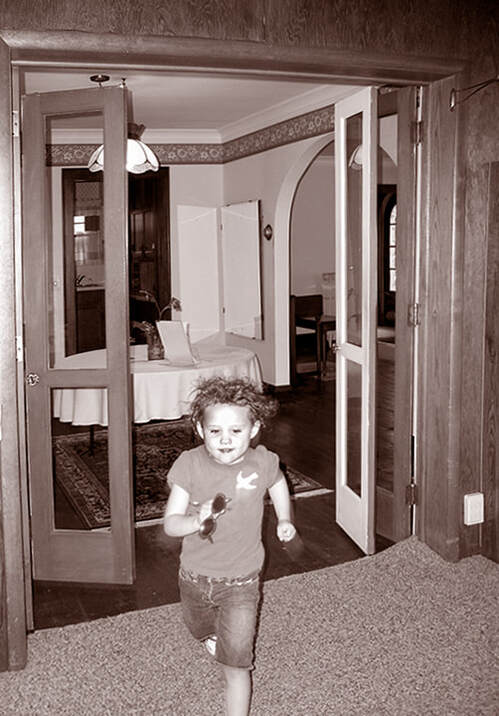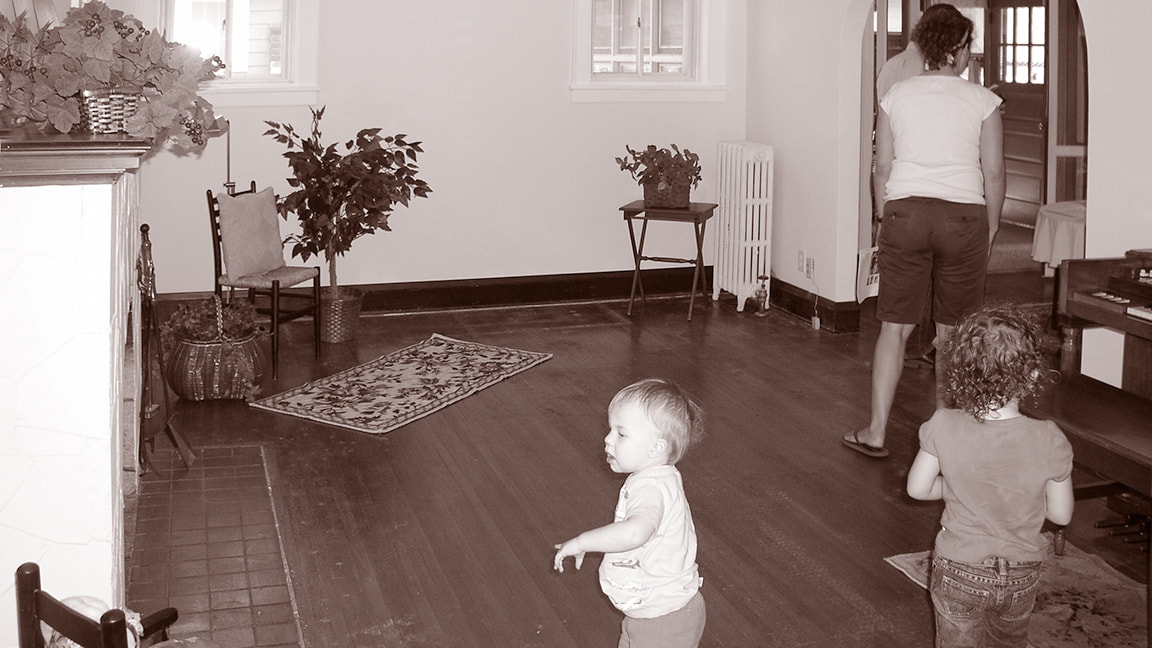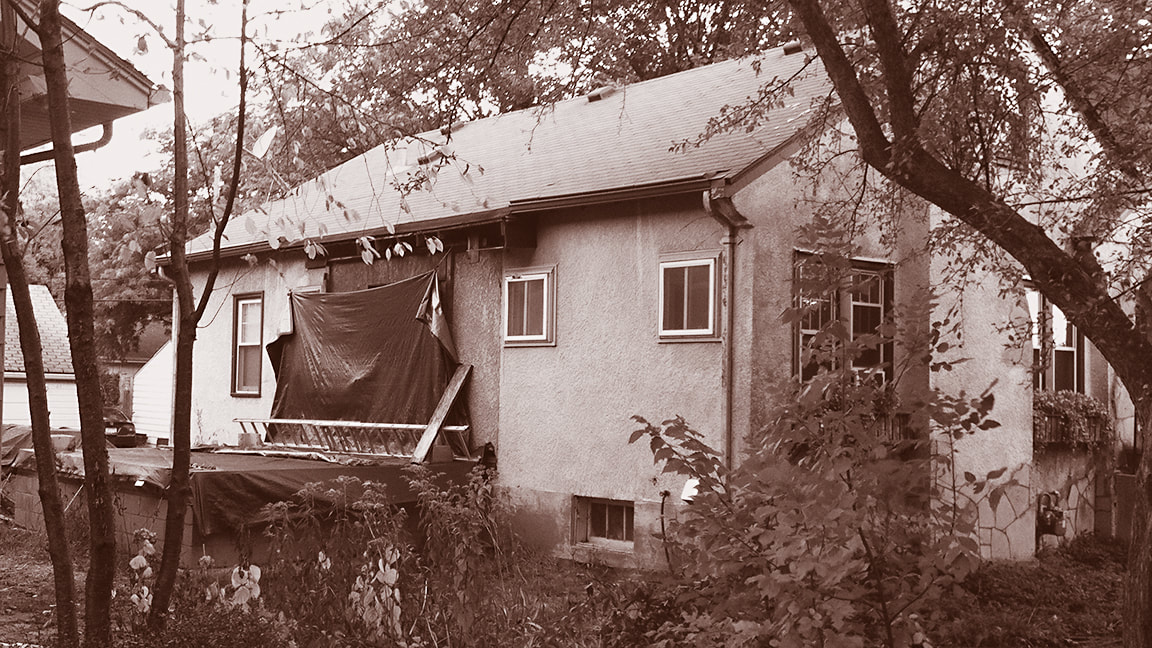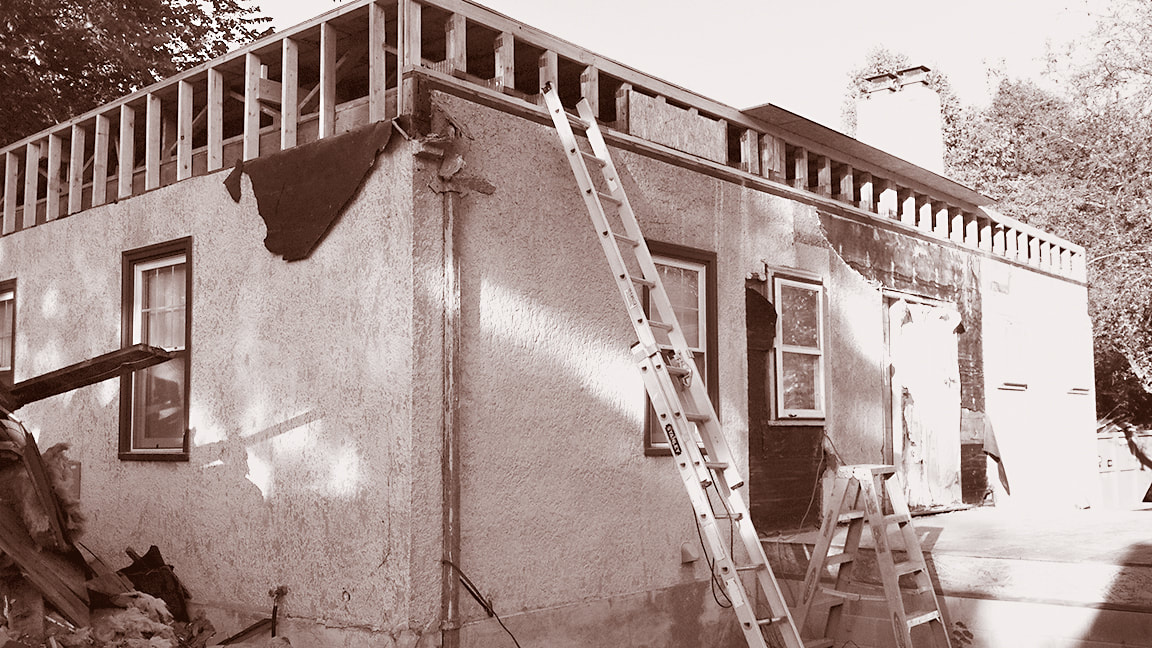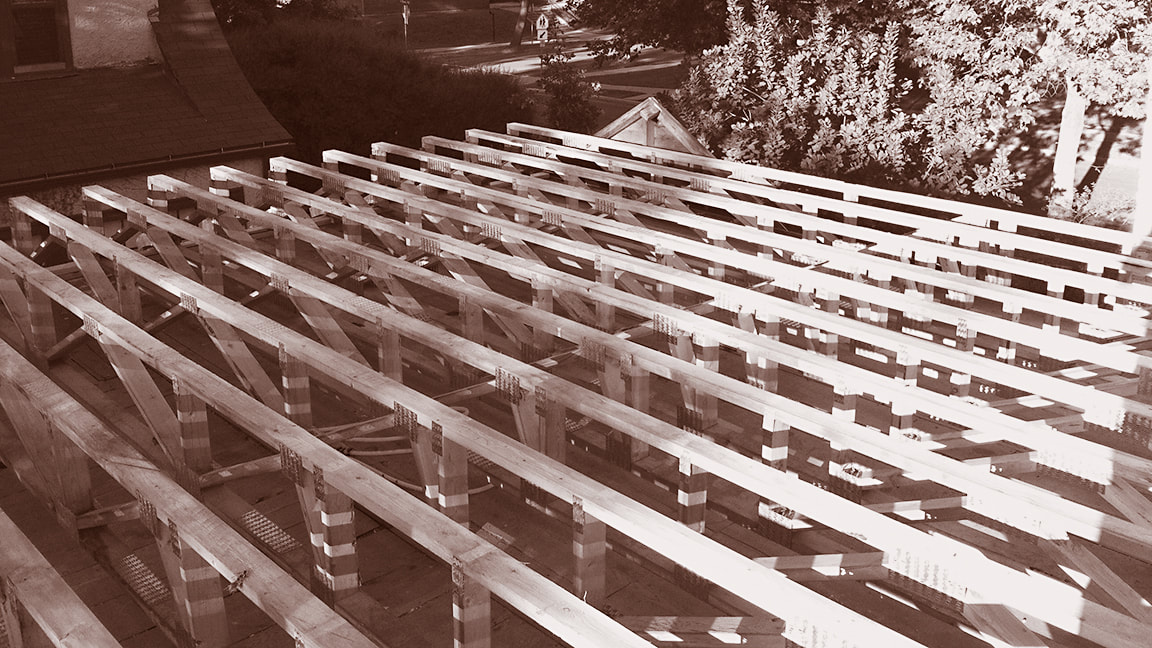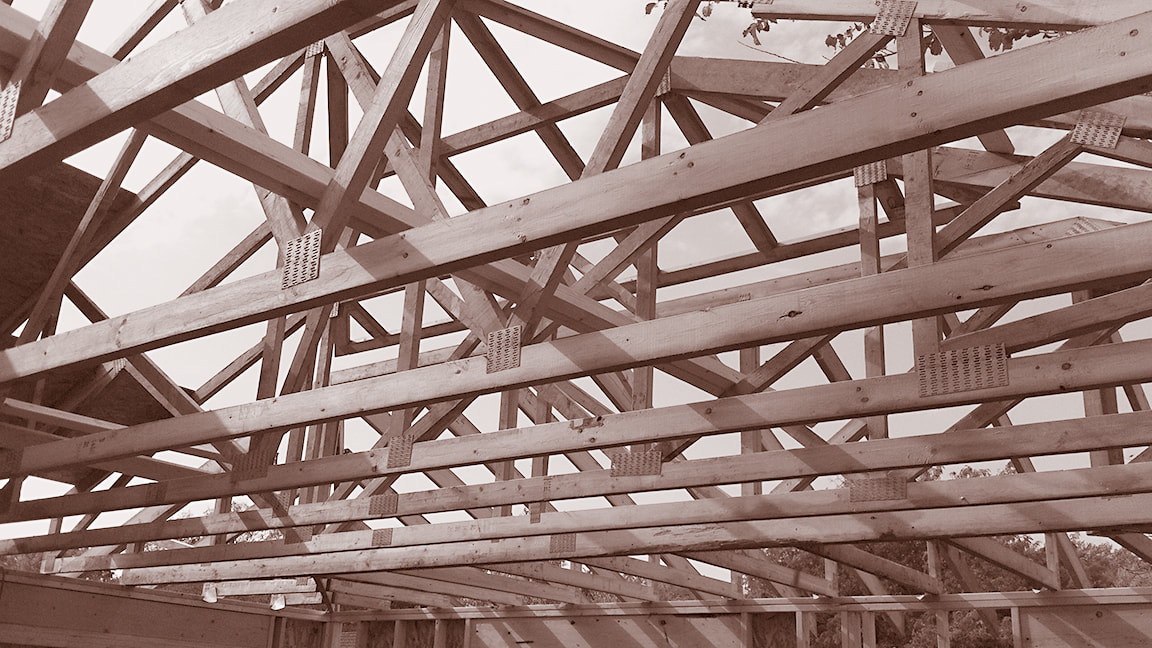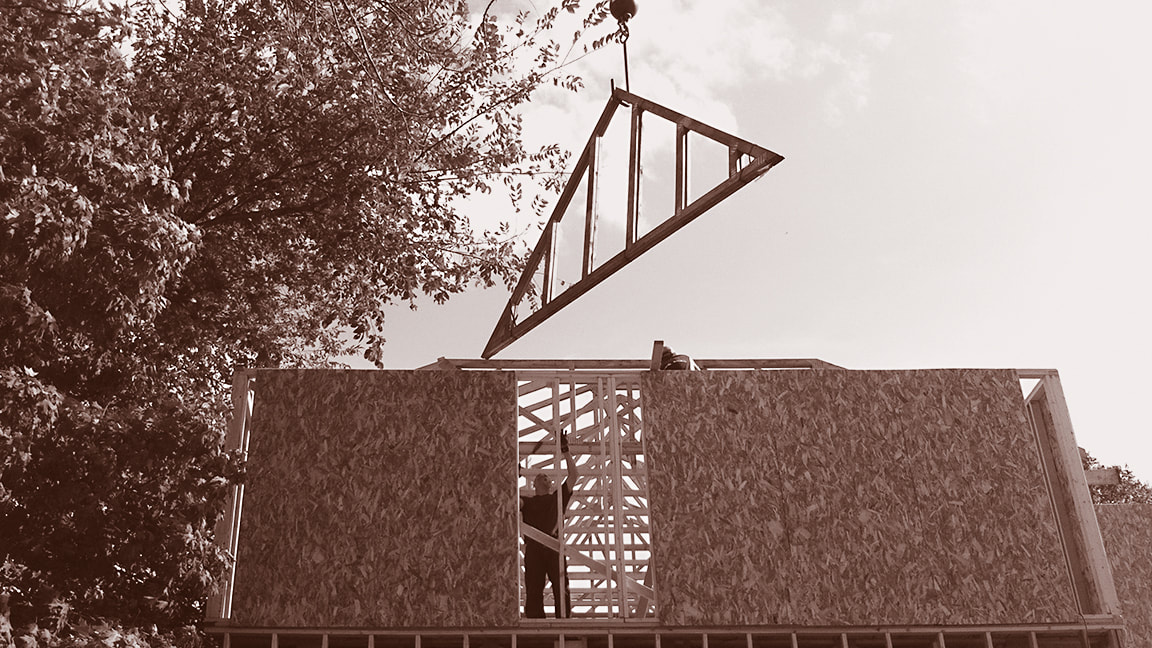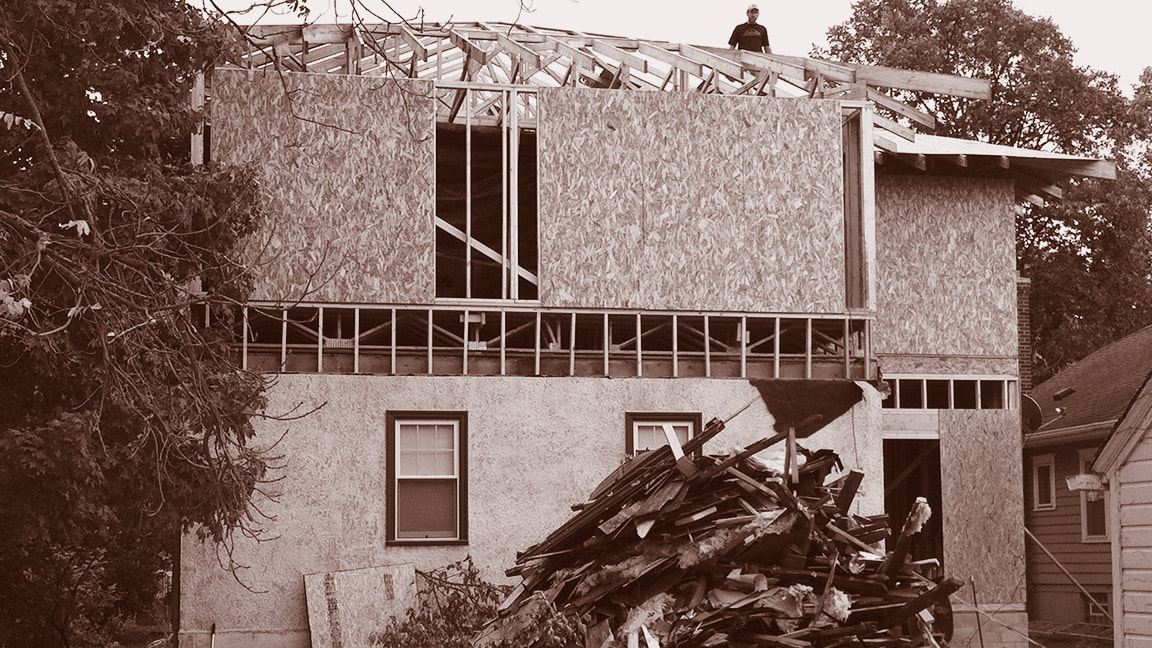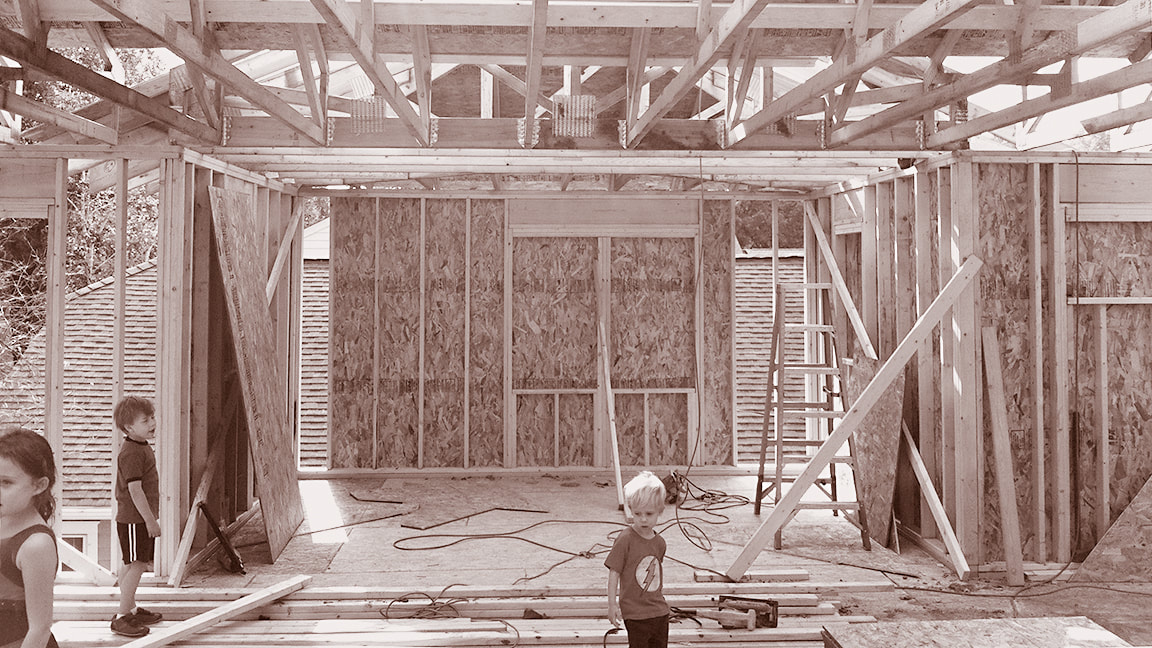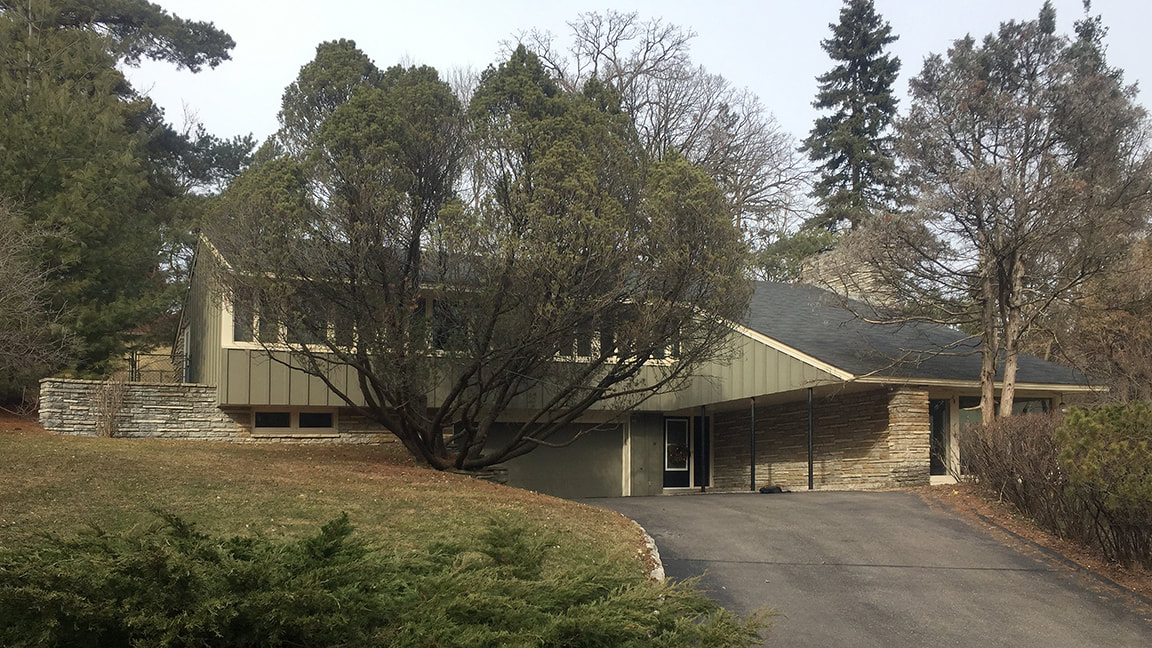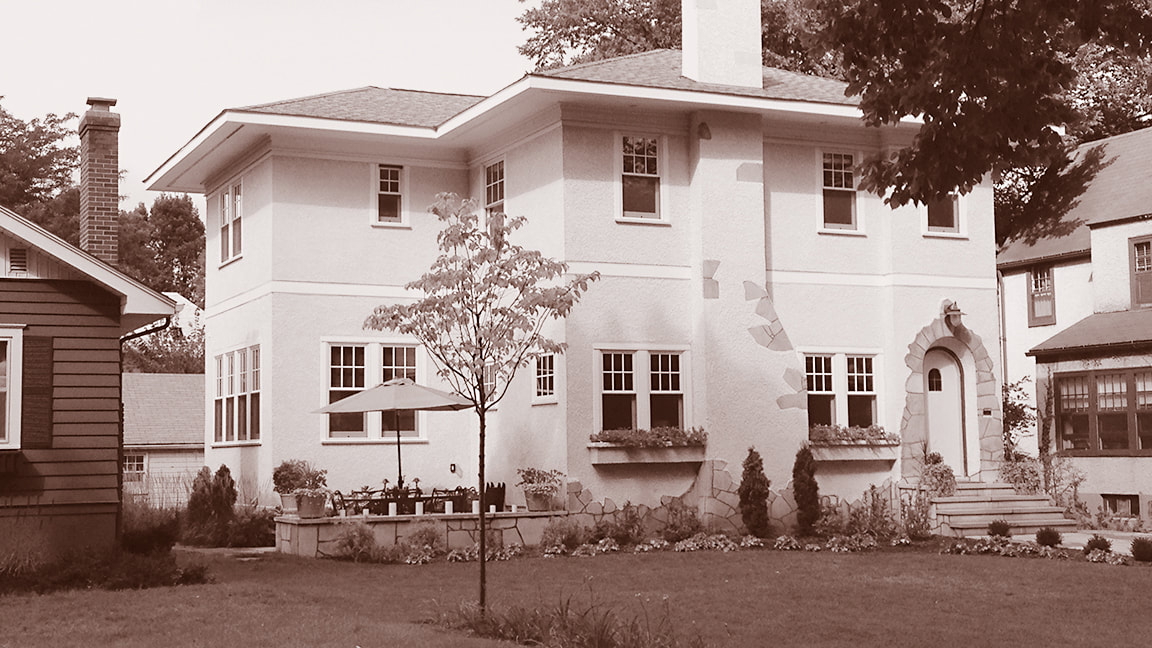P E R S O N A L P O I N T O F V I E W
|
Quick Links
|
Projects our our website are typically presented from a distance, with a professional veneer as they are other people's experiences. |
C A S E S T U D Y
A Case Story, Actually
|
This project has a special place in my heart.
It's my family's house, and we still live in it. And, like all projects, it has a story, one that is still playing out over over a decade later. The intent of Raze the Roof is to share that story - the house's story and my family's. In fact, the two cannot be separated as the history of this project is a master class on general contracting and family dynamics. It was an extended process - full of struggle, frustration, delay, transformation, patience, and joy. And it continues to this day with hard-earned learnings embedded in the foundation of my design firm, David Lund Design. > See the finished project House projects are the byproducts of a family's needs, aspirations, and frustrations and, as such, are reflections of who we are.For better or for worse, we are intimately linked to our homes. The hope is that, in telling our story, it may guide and inform yours. |
RUN SYL RUN How do you best make your way through an open house? Well, you sprint, of course. Seeing how fast our kids got comfortable in the house went a long way in making us feel comfortable with the prospect of taking it on as a project.
|
A N A S I D E
Careful What You Wish For
I couldn't shake it, the desire to design and build my own house.
It wasn't a selfish desire to show others how it should be done; rather, it was based on two simple notions, one pragmatic, the other more personal and nostalgic.
Learning By Doing
The simple fact was that our budget was tight and did not allow for the cost of a builder (and we were already getting the design work for free!). And personally, I had a long-standing belief that every designer or architect should experience what it's like to not only design, but also build their own home.
Doesn't every mechanic learn by working on their own car, I reasoned? Perhaps, but I overlooked a key difference - a mechanic can step away from the project and leave the car outside in the garage. He also doesn't have to live in it while it's under repair.
When it's your money on the line, when the construction schedule, subcontractor network, and budget are your responsibility to manage, when your family's routines are disrupted, when the demolition crew's reciprocating saws wake your kids at 7:30, you get very smart, very quickly about budget and construction realities and what life is like living in a construction zone.
It was my belief then (as it is even more deeply now), that the experience and hard-earned learnings that naturally come from this approach are irreplaceable. I believed, that they would make me a better designer, and a better, more empathetic advocate for any client.
I did not, however, know how right I was.
There were times (like when sheetrock dust was on every item we owned) when I questioned my decision.
But I have never regretted it.
It wasn't a selfish desire to show others how it should be done; rather, it was based on two simple notions, one pragmatic, the other more personal and nostalgic.
Learning By Doing
The simple fact was that our budget was tight and did not allow for the cost of a builder (and we were already getting the design work for free!). And personally, I had a long-standing belief that every designer or architect should experience what it's like to not only design, but also build their own home.
Doesn't every mechanic learn by working on their own car, I reasoned? Perhaps, but I overlooked a key difference - a mechanic can step away from the project and leave the car outside in the garage. He also doesn't have to live in it while it's under repair.
When it's your money on the line, when the construction schedule, subcontractor network, and budget are your responsibility to manage, when your family's routines are disrupted, when the demolition crew's reciprocating saws wake your kids at 7:30, you get very smart, very quickly about budget and construction realities and what life is like living in a construction zone.
It was my belief then (as it is even more deeply now), that the experience and hard-earned learnings that naturally come from this approach are irreplaceable. I believed, that they would make me a better designer, and a better, more empathetic advocate for any client.
I did not, however, know how right I was.
There were times (like when sheetrock dust was on every item we owned) when I questioned my decision.
But I have never regretted it.
Schools Rule
Our house story starts, not with a house, but elsewhere - with a school.
Working with homeowners over the years, we have found that the quality of the local school system is one of the biggest drivers that leads families to seek our help. If a family feels good about the neighborhood schools, they feel good about doing their project.
Without this level of assurance, the decision to trigger a project is often more difficult and drawn out.
We were no different, we just didn't know it yet.
Oakland, Minnesota
By 2007, we had been in our first Minneapolis home on Oakland Avenue for over 10 years.
We were fortunate to find a "starter" house that truly could have been our long-term house. A proud four-square with great curb appeal and charming period detail, it was large enough for our young family.
It was a great house on a great block.
Working with homeowners over the years, we have found that the quality of the local school system is one of the biggest drivers that leads families to seek our help. If a family feels good about the neighborhood schools, they feel good about doing their project.
Without this level of assurance, the decision to trigger a project is often more difficult and drawn out.
We were no different, we just didn't know it yet.
Oakland, Minnesota
By 2007, we had been in our first Minneapolis home on Oakland Avenue for over 10 years.
We were fortunate to find a "starter" house that truly could have been our long-term house. A proud four-square with great curb appeal and charming period detail, it was large enough for our young family.
It was a great house on a great block.
Like many older homes, it had an outdated kitchen and only one upstairs bathroom. But those were minor issues, ones we had easily lived with for a decade. We had considered a project that would have addressed those issues quite nicely, but there was one critical thing we could neither get past nor do much about - the quality of the neighborhood schools.
The quality of community schools in the neighborhood ranged from decent to struggling. We had two young kids who would soon be starting school, so the issue that we never even considered when we bought the house was now the primary reason we were considering leaving the house.
It seems painfully obvious now, but as a newly married couple years away from starting a family, the quality of schools had no bearing on our home purchase decision.
The quality of community schools in the neighborhood ranged from decent to struggling. We had two young kids who would soon be starting school, so the issue that we never even considered when we bought the house was now the primary reason we were considering leaving the house.
It seems painfully obvious now, but as a newly married couple years away from starting a family, the quality of schools had no bearing on our home purchase decision.
Great neighborhood, great struggle
Early on in our search process, my wife had identified Linden Hills as the neighborhood she wanted to live in. Yes, Linden Hills was great, but I was open to other neighborhoods and was reluctant to focus so narrowly so soon.
She made her case based largely on the quality of the community schools, as well as the charming business district, and the incredible number of families with kids.
She was spot on.
A Fixer-Upper of Our Own
What we did both agree on, however, was that we wanted a fixer-upper.
As a young commercial architect, I was dying to turn a solid but tired house into our dream home.
There were several houses surfacing in Linden Hills, and everyone had received multiple offers. We didn't fully appreciate it at the time, but we were looking for homes in a hot neighborhood during one of the hottest real estate markets in our city’s history. In fact, we were looking for a home during the final and highest spike in a 10-year long, extended residential real estate boom.
As buyers, we had little leverage.
Finally a house went on the market, near a local school. As much as we believed in strong community schools, we were less certain we wanted to live near one. But the photos were intriguing, so we attended the open house.
It was a mess and it was perfect.
Its beleaguered condition limited the interested parties. Before we had even submitted a purchase offer, this house was ours - in our minds. We had started the process of mentally "moving in", talking about what the project would be, where furniture would go, and what our maximum construction budget was.
The excitement and enthusiasm we felt is akin to what homeowners feel during the Schematic Design phase, and it's wonderful. For the first time saw what things might look like, how our house would be.
It was intoxicating.
She made her case based largely on the quality of the community schools, as well as the charming business district, and the incredible number of families with kids.
She was spot on.
A Fixer-Upper of Our Own
What we did both agree on, however, was that we wanted a fixer-upper.
As a young commercial architect, I was dying to turn a solid but tired house into our dream home.
There were several houses surfacing in Linden Hills, and everyone had received multiple offers. We didn't fully appreciate it at the time, but we were looking for homes in a hot neighborhood during one of the hottest real estate markets in our city’s history. In fact, we were looking for a home during the final and highest spike in a 10-year long, extended residential real estate boom.
As buyers, we had little leverage.
Finally a house went on the market, near a local school. As much as we believed in strong community schools, we were less certain we wanted to live near one. But the photos were intriguing, so we attended the open house.
It was a mess and it was perfect.
Its beleaguered condition limited the interested parties. Before we had even submitted a purchase offer, this house was ours - in our minds. We had started the process of mentally "moving in", talking about what the project would be, where furniture would go, and what our maximum construction budget was.
The excitement and enthusiasm we felt is akin to what homeowners feel during the Schematic Design phase, and it's wonderful. For the first time saw what things might look like, how our house would be.
It was intoxicating.
BONUS CONSIDERATION If you are seriously considering a major remodel, hope that there is carpet everywhere. The carpet on the main level had been removed just before the open house to make it more "updated". What was also revealed were pristine hardwood floors that had not been touched in over three decades. Nice.
If at First You Don't Succeed, Wait for the Other Deal to Fall Through
Much to our shock, we didn't get the house [we lost it to a "flipper" we later learned]. We were devastated, a bit disorientated, and deeply discouraged. If this situation didn't work, it was hard to imagine one that would. Uncoupling emotionally from something you are deeply connected to is beyond difficult.
A week after our offer was rejected, we got a message from our real estate agent. Good news, the developer had pulled his offer, and we had a second shot at the house.
The developer's uncertainty became our opportunity. We proved the adage that a motivated home buyer will always pay more for a house than an investor. We jumped at the chance.
Finally we had a house that was ours! We were thrilled.
All we had to do now was design, bid, and build a whole-house renovation - all while living in it.
Much to our shock, we didn't get the house [we lost it to a "flipper" we later learned]. We were devastated, a bit disorientated, and deeply discouraged. If this situation didn't work, it was hard to imagine one that would. Uncoupling emotionally from something you are deeply connected to is beyond difficult.
A week after our offer was rejected, we got a message from our real estate agent. Good news, the developer had pulled his offer, and we had a second shot at the house.
The developer's uncertainty became our opportunity. We proved the adage that a motivated home buyer will always pay more for a house than an investor. We jumped at the chance.
Finally we had a house that was ours! We were thrilled.
All we had to do now was design, bid, and build a whole-house renovation - all while living in it.
THIS IS IT? The house a month before we moved in. It's hard now to remember how it looked originally. Our advice? Take pictures of your home before your project starts. You will be amazed by the change and reminded years later of what things used to look like.
Underway, kind of
Our purchase offer was not contingent upon the sale of our old house.
In that white-hot housing market, sellers in Linden Hills would not work with buyers who still needed to sell their house. With no other options, we closed in September 2007, now the proud owners of two houses.
White Hot, Red Flag
What we did not know is that only months later, the real estate market and the overall economy would begin to unwind. Although there was tremendous interest, we were unable to sell our first home quickly. It was our first taste of what was about to come.
We had over two dozen showings - great interest, but with two young kids, the effort and stress of preparing and vacating the house was exhausting.
As our house sat for month after month, we did however have the exciting task of designing our new project, and it was coming along beautifully. Everything had a place, the layout was efficient, and rooms were generous.
> See the finished project
There is little more exciting than planning a project for your family. Everything is possible, cost is not yet an issue yet, and the conversations are exhilarating. We pored over the options, researched fixtures and materials, construction methods, sustainability strategies, and considered ways to make each bedroom unique for our two kids.
As exciting as the design process was, we were a bit early.
Three years to be exact.
In that white-hot housing market, sellers in Linden Hills would not work with buyers who still needed to sell their house. With no other options, we closed in September 2007, now the proud owners of two houses.
White Hot, Red Flag
What we did not know is that only months later, the real estate market and the overall economy would begin to unwind. Although there was tremendous interest, we were unable to sell our first home quickly. It was our first taste of what was about to come.
We had over two dozen showings - great interest, but with two young kids, the effort and stress of preparing and vacating the house was exhausting.
As our house sat for month after month, we did however have the exciting task of designing our new project, and it was coming along beautifully. Everything had a place, the layout was efficient, and rooms were generous.
> See the finished project
There is little more exciting than planning a project for your family. Everything is possible, cost is not yet an issue yet, and the conversations are exhilarating. We pored over the options, researched fixtures and materials, construction methods, sustainability strategies, and considered ways to make each bedroom unique for our two kids.
As exciting as the design process was, we were a bit early.
Three years to be exact.
SORRY NEIGHBORS Shortly after moving in, we removed the existing sunroom as it was pulling from the house and leaking. Due to my unemployment, our project sat this way for nearly three years. The temporary plywood wall made for a lovely artwall in the dining room.
A New Addition
When my wife got pregnant with our third child, the upper level that worked so well for four, now had to be re-worked for five. Kid number three was on the way.
But hey, more design work!
So back to the drawing board I went. During this process we proved another adage, no one will spend more time designing their house than an architect. That is a rabbit hole with no bottom.
In January, while still carrying two mortgages, I was laid off from my job as a commercial architect. That same week, some good news finally came in the form of a low-ball offer on our old house, which we begrudgingly accepted.
By March of 2008, we moved in to our "new" house and found ourselves in a fixer-upper, with two young kids (a third on the way), me with no job, no project financing, and consequently no viable project.
Well, at least over the last six months, I had spent nights and weekends demolishing the kitchen, basement and upper level, leaving them raw and unusable spaces.
The five of us would have to share one bathroom, two bedrooms on the main level - without a working kitchen.
Not necessarily the best start, but at least we were moving in!
When my wife got pregnant with our third child, the upper level that worked so well for four, now had to be re-worked for five. Kid number three was on the way.
But hey, more design work!
So back to the drawing board I went. During this process we proved another adage, no one will spend more time designing their house than an architect. That is a rabbit hole with no bottom.
In January, while still carrying two mortgages, I was laid off from my job as a commercial architect. That same week, some good news finally came in the form of a low-ball offer on our old house, which we begrudgingly accepted.
By March of 2008, we moved in to our "new" house and found ourselves in a fixer-upper, with two young kids (a third on the way), me with no job, no project financing, and consequently no viable project.
Well, at least over the last six months, I had spent nights and weekends demolishing the kitchen, basement and upper level, leaving them raw and unusable spaces.
The five of us would have to share one bathroom, two bedrooms on the main level - without a working kitchen.
Not necessarily the best start, but at least we were moving in!
A FORCE FOR CHANGE Now, almost a teenager, our youngest son prompted a whole new round of design development. It was only the first of many things he would disrupt.
Ultimately, I was out of work for three years. As difficult as that time was, it was a powerful teacher, as well.
Living in a home that was too small, inefficiently laid out, and unfinished - created a sense of never having moved in. Being unsettled in your home is stressful.
Not liking your environment can be toxic - if you let it be.
Living in a home that was too small, inefficiently laid out, and unfinished - created a sense of never having moved in. Being unsettled in your home is stressful.
Not liking your environment can be toxic - if you let it be.
Learnings, in the end
ON DECK On an upper level addition, this is the point of greatest relief. A new, solid, flat plinth upon which to build. From this point on the remodeling project runs more like a new construction with no surprises or obstructions.
Unfit
Perhaps the greatest take away is hardest to quantify.
Our experience imparted a deep understanding of how unsettling it is to live in a house that doesn't "fit". Little else builds greater empathy and insight into the impact of a construction project on a family like ripping the roof off of your own house - while continuing to live in it with three young kids.
> See the finished project
Lessons learned this way are not easily forgotten. We bring that experience to all of our projects and work tirelessly to produce complete and detailed drawing sets that reduce delays, minimize mistakes, and get you back in your house sooner.
Perhaps the greatest take away is hardest to quantify.
Our experience imparted a deep understanding of how unsettling it is to live in a house that doesn't "fit". Little else builds greater empathy and insight into the impact of a construction project on a family like ripping the roof off of your own house - while continuing to live in it with three young kids.
> See the finished project
Lessons learned this way are not easily forgotten. We bring that experience to all of our projects and work tirelessly to produce complete and detailed drawing sets that reduce delays, minimize mistakes, and get you back in your house sooner.
Our Lemonade
But a change in our perspective, of working with what we had instead of what we didn't, allowed us to adapt creatively to our situation and find unique ways to make the spaces work.
The temporary plywood wall in the dining room (covering the opening to the future sunroom) became the kids' art wall. With only one bedroom, all three kids shared one bedtime, even with a 5 year age range, making it a delicate, but efficient process.
Our living room doubled as my office. And due to an intense need for additional and separate spaces, Tara proposed adding a patio to our future project. It has become unquestionably the most used and best addition to our house project.
Just ask our neighbors.
But a change in our perspective, of working with what we had instead of what we didn't, allowed us to adapt creatively to our situation and find unique ways to make the spaces work.
The temporary plywood wall in the dining room (covering the opening to the future sunroom) became the kids' art wall. With only one bedroom, all three kids shared one bedtime, even with a 5 year age range, making it a delicate, but efficient process.
Our living room doubled as my office. And due to an intense need for additional and separate spaces, Tara proposed adding a patio to our future project. It has become unquestionably the most used and best addition to our house project.
Just ask our neighbors.
Sit And Wait
Another unintended benefit of my extended unemployment was that we were forced to sit with our designs.
We took the opportunity to tweak, adjust, and improve our project. I don't recommend waiting nearly four years before starting your project, but I do recommend taking your time with the design and documentation process.
At the start of every project there is a strong desire to dig in and get going. In the rush to get to the project under way and under construction, sometimes projects proceed without being fully understood or vetted by the homeowner. Once under construction, this can result in strong feelings of uncertainty, even regret.
To guard against this, we introduce "speed bumps" in our design process and make it a point to thoroughly review the project at the end of each design phase. We proceed only once the homeowner is comfortable with the design direction and grants us written permission to proceed.
Another unintended benefit of my extended unemployment was that we were forced to sit with our designs.
We took the opportunity to tweak, adjust, and improve our project. I don't recommend waiting nearly four years before starting your project, but I do recommend taking your time with the design and documentation process.
At the start of every project there is a strong desire to dig in and get going. In the rush to get to the project under way and under construction, sometimes projects proceed without being fully understood or vetted by the homeowner. Once under construction, this can result in strong feelings of uncertainty, even regret.
To guard against this, we introduce "speed bumps" in our design process and make it a point to thoroughly review the project at the end of each design phase. We proceed only once the homeowner is comfortable with the design direction and grants us written permission to proceed.
Finally. with the floor and walls and roof trusses in place, some real space is being created. Our kids loved to wonder around, all the way to the edges, which was not stressful, at all.
Empathy 101
Our construction budget included no money for a builder, as I wanted the experience of both designing and managing our project. Serving as the construction manager on the project was a chance to learn by doing.
I don't necessarily recommend home owners do it this way, but it satisfied a long-standing belief I had that every architect should not only design, but renovate their own home. Going through the stress, mess, disruption, scheduling, coordination and responsibility of running a construction project is a master class in the design and construction process.
It is also a great way to build empathy for what homeowners go through. There's nothing like ripping the roof off of your house to make you feel a little exposed.
Our construction budget included no money for a builder, as I wanted the experience of both designing and managing our project. Serving as the construction manager on the project was a chance to learn by doing.
I don't necessarily recommend home owners do it this way, but it satisfied a long-standing belief I had that every architect should not only design, but renovate their own home. Going through the stress, mess, disruption, scheduling, coordination and responsibility of running a construction project is a master class in the design and construction process.
It is also a great way to build empathy for what homeowners go through. There's nothing like ripping the roof off of your house to make you feel a little exposed.
Rising up out of the overgrown landscaping, our upper level addition began to take shape. To this day, people are still surprised to learn that the house has not always been this way. Thank you.
Sinking In
At the end of our project, it took me nearly six months to adjust mentally to the notion that we had a new, habitable upper level. I would go through long stretches each day, forgetting that we now had finished space above us.
It was odd to feel surprised by my own house, one that I had designed and built.
Slowly, our new living condition integrated with my outdated perceptions. Memory of our struggles faded, too, leaving another learning in its place.
No matter how disruptive your construction experience might be, you do eventually forget it, and in the end, the new spaces slowly replace the old and you cannot imagine living any other way.
At the end of our project, it took me nearly six months to adjust mentally to the notion that we had a new, habitable upper level. I would go through long stretches each day, forgetting that we now had finished space above us.
It was odd to feel surprised by my own house, one that I had designed and built.
Slowly, our new living condition integrated with my outdated perceptions. Memory of our struggles faded, too, leaving another learning in its place.
No matter how disruptive your construction experience might be, you do eventually forget it, and in the end, the new spaces slowly replace the old and you cannot imagine living any other way.




